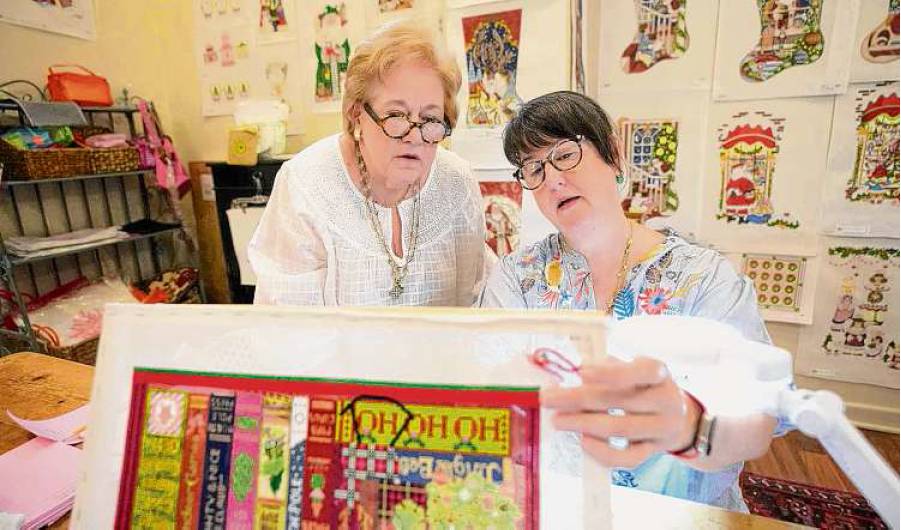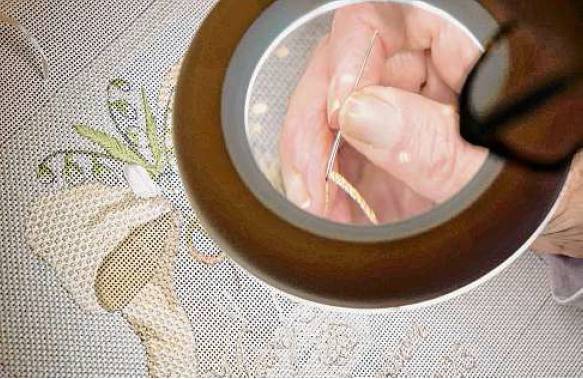Shops sow community
Rice Village boasts two needlepoint spots, broad audience
By Megan Munce STAFF WRITER
Walk just north of Rice Village’s modern retail shops and you’ll find yourself in front of not one, but two, stores focused on an ancient art: Both offer thread, needles and classes to a small but growing group of needlepoint devotees.
On one side of Tangley Street, Frances Jue’s Stitches in Time is dominated by a weathered wooden table where her customers gather to delicately embroider three-dimensional rabbits and garden scenes inspired by Jue’s trips to France. On the other side, Nancy Laux’s Needle House has not one, but three, rooms covered wall to wall in thread of every color.
Their customers range from grandmothers to plastic surgeons to little girls dropped off by their fathers. Laux admits she used to worry that needlepoint was a dying art. But you wouldn’t know it by these two thriving shops.
“Each shop has its own personality and style, their own specialties,” said Helen Shultz, who shops at both stores. “There’s always something you can learn from different people.”
Evolution
Laux and Jue, who have stitched for longer than many of their customers have been alive, haven’t always been competing business owners. The relationship has evolved over several decades.
It started with Jue shopping at the original Needle House store near Lamar High School near River Oaks. Laux, who volunteered at the store before buying it in 1994, began stitching when she was young. Each member of her family could beautifully sew, she explained, so needlepoint — creating art with needle and thread on a type of canvas — was a way to try something new.
Like Laux, Jue’s love of needlepoint originated with her family, who immigrated from Guangzhou, northwest of Hong Kong, in the early 1960s. Her father had a firm commitment to the tradition of paying a dowry for each of his five daughters. So Jue learned to stitch and other technical skills, providing a dexterity that lead to a career as a dentist while she continued her hobby.
In 1995, the two women became business competitors with stores separated by a few miles after Jue opened Stitches in Time near the Galleria. Then, around 2011, she moved her business to the space on Tangley.
About five years ago, they became neighbors. Laux’s River Oaks location was being torn down and redeveloped. While looking for a new location, she found it in the building across from Jue’s shop.
Most of the needlepoint shops in Houston — which Laux can name from memory like letters of the alphabet — are clustered together, she said. Laux isn’t sure why, but guesses it might have to do with sharing a devoted clientele from throughout the city.
Because no two needlepoint shops are the same, customers like to shop among all of them, Jue and Laux said.
“If you have a teacher that tells you they’re the only one in the city, you need to go somewhere else,” Laux advises. “Everyone brings something new to the table.”
Different employees have different skills and experience, and different stores have different canvas selections, Shultz said. On any given day, a customer might head to Stitches in Time to consult with Jue for her expertise with three dimensional designs, then cross the street to join Laux’s waitlist for special-order Astros World Series canvases.
An industry revived
Shultz is an example of one of those customers. She started stitching in 2019, when she was pregnant with her second daughter. At the suggestion of a friend of her mother’s, she took a class at Needle House, where she “fell in love” with the art.
Now she shops at several of Houston’s needlepoint stores. She’s made ornaments for her children, a Christmas stocking for her husband and countless more items, some of which are displayed in Jue’s shop.
At 38, Shultz is a relatively young face among stitchers, Jue said.
But since the pandemic started, Laux and Jue have seen more women of Shultz’s generation get into needlepoint. It’s been a “blessing,” Laux said. Their impact of younger customers is visible in her store, where canvases of nativity scenes and spring flowers are joined by the Peloton logo and one that reads “girl boss.”
“Especially pre-COVID, we were living in such a fast world. And then all of the sudden, the world stopped. People had this appreciation of handiwork and doing things by hand.” Shultz said. “When there was so much anxiety and uncertainty, (needlepoint) was something you could do with your hands, be methodical and take your mind off other worries.”
Meredith Turner, 43, has been taking needlepoint lessons at Needle House since she was 13. At some points she’d be the only woman in the room who wasn’t her grandmother’s age, she said, but now she’s in an online messaging group with about 75 other women around her age who share thread and talk about where to buy new canvases.
It’s a hobby that costs both time and money: Many hand-painted canvases can go for hundreds of dollars, and Shultz said it can take hundreds of hours to complete a piece, depending on its size and complexity.
But the end result makes it worth it, she said.
“Now it’s an heirloom treasure,” Shultz said. “It’s something your family and future generations can enjoy.” megan.munce@chron.com



